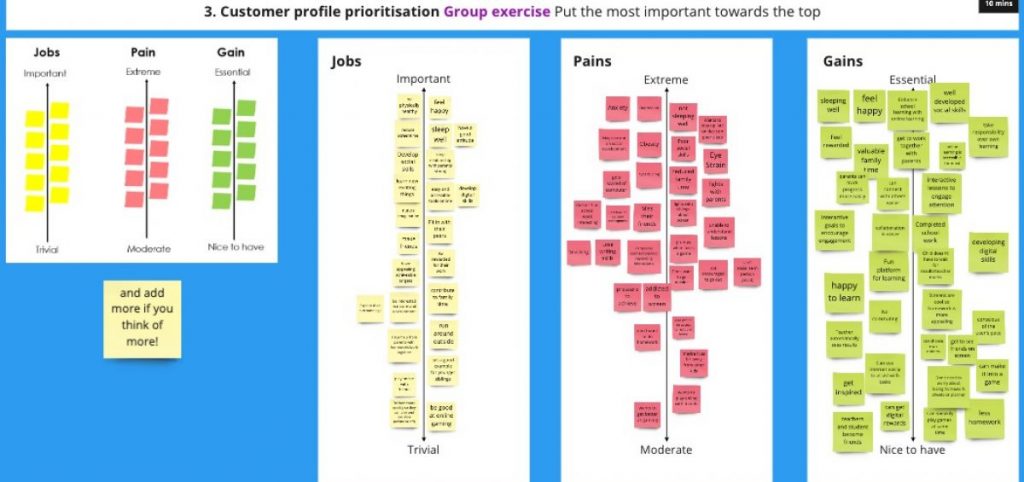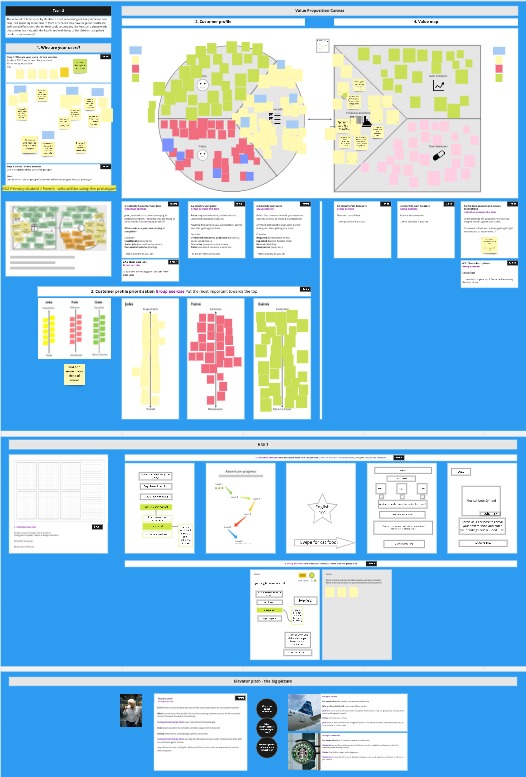
A few months ago, we gave a talk on ‘human centred design’ to this year’s Digital Publishing MA students at Oxford Brookes. We then ran a 3-hour analysis and ideation workshop as part of a course that takes students through a research and design project following user centred design methodology. Here we talk with Adam Blades, the leader of that course, to hear why he invited Bunnyfoot to participate, what he thought of the approach we took and what benefits he thinks students gain from hands on experience of user centred design.
Hi Adam, thanks for joining me today. Could you start by telling me a bit about the courses you teach at Oxford Brookes?
We offer two MA’s, one in Publishing and the other in Digital Publishing. We have around 50-60 students each year across these courses and it’s very international with about half the students coming from overseas. There’s a focus on trade publishing in the first semester, including modules on production, design, editorial, sales and marketing and then in the second semester, students have the option to specialise in areas such as academic and professional publishing, children’s publishing, fiction / non-fiction, book history and culture, and my module on digital publishing strategy
You spent a week with us in the Oxford Bunnyfoot office a couple of years ago. What motivated you to do that?
I was given the Digital Publishing Strategy module to teach when I joined Oxford Brookes in 2018. I had some experience of UX as I’d worked at General Assembly for a bit and had done their accelerator course in user experience. So, I was happy to get this course. One of the assignments on the course is in collaboration with Pearson. They give us a number of briefs and students conduct research and come up with a product or service to address the brief they receive. It went well when I ran it in 2018-2019, but I also felt that I wanted to get a deeper insight into what UX looks like in industry.
Bunnyfoot have a local Oxford branch and we started by inviting you to give a guest talk, which was great. I thought ‘this seems like the perfect company, if they’re willing, to get the insight that would really help inform this class.’ It’s also something I was personally interested to explore further. I reached out and that’s how it happened.
Bunnyfoot have a wonderful client list and that’s appealing both to myself and the students. But deeper than that, the impression I had from the outside was that Bunnyfoot aren’t part of the new wave ‘fluffy’ version of user experience, which may deal with UX more superficially and doesn’t really conduct good research, instead focusing on cool layouts, designs that look interactive and fun but without necessarily validating the experience and user needs behind it. Because Bunnyfoot has been around for a relatively long time and their approach to research seems much more thorough, it was clear that by working with Bunnyfoot we would get a more grounded look into user experience. And through working with you, I found this to be true.
The Digital Publishing Strategy course takes students through the process of receiving a brief, conducting research, doing analysis, ideation, design and prototyping, and then testing this prototype with end users. Was it a conscious decision to take them through a user centred design process?
Yes, it is deliberate. We tell the students there’s a difference between producing print and digital products. With a book, you don’t need to think too hard about how it’s going to function. And there might be higher initial costs with digital. So, this means we need to take a different approach. We need to validate the idea, we need to understand our users, we need to ensure it’s solving a problem, and we need to prototype and test it. This way, we can ensure that it is of value to people before we invest too much money in it. For me, this means following a user centred, design thinking model.
What do you think the students benefit from doing this?
The first thing is that they are working with a real brief from a real company (Pearson). It’s good to create that link between the classroom and industry. This is motivating for the students. They can see how it could apply to their working lives in the future.
In terms of the process, it can be against people’s nature to follow a user centred design framework because whenever we come up with an idea, we are the centre of that idea. We have a bit of a curse of knowledge: ‘I’ve come up with this idea and I think it will be perfect.’ We think we know enough.
We want to champion the idea that we aren’t doing this for ourselves. This isn’t like your other assignments where your opinions will be read by your lecturer. This is about solving a problem out there in the real word. It therefore requires a different mindset, a different approach, to get them out of their own head and into the head of another. I think this really benefits them.
You invited us to run session 2 of the course, the ideation stage, which we did remotely using Zoom and a digital whiteboard (Miro). The students were in teams and had already done some research relevant to their briefs. Why did you ask us to get involved with that particular session?
I have run this module two times before and it is the hardest stage of the process to get right. Everything converges in the ideation stage and then comes out of that. It’s a really important step to get right and it’s important that the students take it seriously.
We sometimes need to help them get over the first ideas that they have before conducting any research. Some just want to stick with this idea regardless of what opportunities the research presents them. If a guest lecturer from industry comes in, the students immediately pay attention.
You were able to draw on your experience at Bunnyfoot in terms of the activities you used, the pacing of the session, how to spot and manage issues, to see where and when some direction was needed. This was invaluable and entirely dictated the rest of the students’ work from there.

We used the Value Proposition Canvas as a key workshop activity. What did you think of this technique?
This was my favourite part. It was core to the ideation process because it clearly lays out the transition that is happening in the class. We are moving from explicitly exploring the users’ jobs, pains, and gains, and now we are transitioning that into a solution. It really holds students’ hands through this process and ensures that the work they put into user research gets followed through into the outcome. As opposed to what would likely happen otherwise, where students think ‘we’ve done the research, let’s forget that now and do the fun stuff of designing something.’ The value proposition canvas ensures a strong bond between those two sides of research and design.

How did things progress from there?
It went pretty smoothly. The tricky thing is getting the idea. Once they have it, they are on a downhill slope, putting together a prototype and testing it.
The first time I ran the course, I got students to end by putting together a business proposal for their idea. When I did the internship with Bunnyfoot, it was eye opening to see how you present findings and reports. On the back of that, I got students to present their reports more visually using PowerPoint or Keynote, showing the journey they’d been on, what the brief was, what research they’d done, their use of personas, the ideas they had and how they identified the one they went with, how they evolved their prototypes and so on.
The impression you should have got by now is that Bunnyfoot were a crucial part of making the assignment a success and without your input the students wouldn’t have got as much out of it and the results for Pearson would not have been so good. The talks you gave and the workshop you did was illuminating for students, some of whom have since said to me, ‘I didn’t even know user centred design was a thing, and now I’m really interested in it.’

Thanks Adam, it was great to be a part of the students’ experience this year. They obviously enjoyed the whole course and the final projects you showed me are impressive. I am sure they got a lot from the experience. Thanks for getting us involved.
Want to learn more about the user centred design process?
We run training courses on user centred design, including our 1-day Fundamentals of UX and Design Thinking course, and our 3-day certification course. We also teach a Customer Journey Mapping, modelling and IA course that shows how to bridge the gap





